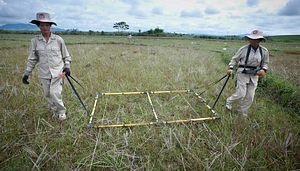Last week, Laos and the United Nations Development Program (UNDP) inked a new support project document focusing on clearing unexploded ordnance (UXO). Though the process itself was fairly routine, it nonetheless illustrated the Southeast Asian state’s continued struggle in this realm.
Laos’ UXO challenge is a significant one and one that dates back to the Vietnam War, when more than 2 million tons of bombs dropped on all of its provinces (or nearly one ton for every man, woman, and child in the population at the time).
Today, Laos remains the most UXO-affected country in the world. According to the UNDP, nearly a third of the cluster munitions are estimated to have failed to explode and remain in the ground across 15 of the country’s 18 provinces, and though casualties have been dropping from year to year with clearance and risk education, dozens are still killed, injured, or maimed by UXOs each year. Beyond the casualties themselves, the presence of UXO also poses a development challenge as it restricts access to land and makes constructing infrastructure and supporting facilities more costly and risky.
The UNDP, along with other organizations and Western donor countries, have played an important role in assisting the Lao government in addressing this issue. With their help, the government set up the Lao National Unexploded Ordnance Program (UXO Lao) in 1996, which functions as the national UXO clearance operator, and the National Regulatory Authority for UXO and Mine Action (NRA) established in 2005, that acts as the regulator. Over the past few years, Laos has made some inroads, not just in terms of clearing, but conducting risk education visits and even adopting new evidence-based survey methodology.
On July 7, as part of its continuing efforts in the UXO sector over the past two decades, the UNDP signed a new project document with Laos. The document, which was signed by Minister of Labor and Social Welfare Khampheng Xaysompheng and UNDP Resident Representative Balasubramaniam Murali, comprises a financial envelope of $84 million and will be funded via UNDP to the project or directly from bilateral donors. The document focuses on a variety of areas ranging from establishing a national baseline of UXO contamination to new partnerships on gender.
The scope of the project, which will last until the end of 2021, is also in line with Laos’ own national sustainable development goal – SDG18: Lives Safe from UXO – which had been launched by the Lao premier and then-UN Secretary-General Ban Ki-moon during the ASEAN Summit in Vientiane in September 2016. SDG 18, which is a national goal Laos has set apart from the 17 global goals set by the UN for sustainable development, includes various targets that would be consistent with this project, including eliminating casualties and supporting healthcare and livelihoods of UXO victims.
Though this is all well and good, it will now be up to Laos and its partners to see if they can realize the SDG 18 targets. That will depend not just on things like implementation, but continued donor support to address what the UNDP called a “substantial funding gap.”

































